Does your horse come to a screeching halt and then leap like a deer on crack or turn into a nervous mess when you ask him to walk into or out of his stall? Horses balking about entering or leaving their stalls are more common than you might think, and the situation has the potential to turn dangerous quickly. Your horse can easily run into you or slip and fall. Luckily, building your horse’s confidence about going into and out of his stall just takes patience and a good dose of common sense.
Before we get started, it’s important to note that just like any other behavior problem your horse has, rushing into and out of stalls can be solved by taking him through the Fundamentals level of the Method. Problems, whether they’re caused by fear or a lack of respect or a combination of both, can be solved by moving the horse’s feet forwards, backwards, left and right and always rewarding the slightest try. Once you’ve earned your horse’s respect and trust, the problem is likely to go away on its own. If it doesn’t, here’s how to fix it.
If your horse develops a fear of passing into and out of stalls, it’s often because he’s been “bitten” by the door or gate. By that, I mean that when he’s passed into or out of the stall the gate banged against his body and scared him or maybe even injured him. If something makes your horse feel uncomfortable, he isn’t likely to want to repeat the experience.
The other likely culprit is simply your horse’s natural wariness of tight, narrow spaces. Because horses are prey animals, when they are made to go in tight, narrow spaces—such as a stall gate—it’s natural for them to feel trapped and claustrophobic. When a horse feels trapped and claustrophobic, and his ability to run and move his feet is taken away from him, the only other option he feels he has is to fight—kick, bite, strike or do whatever else he can to survive the situation.
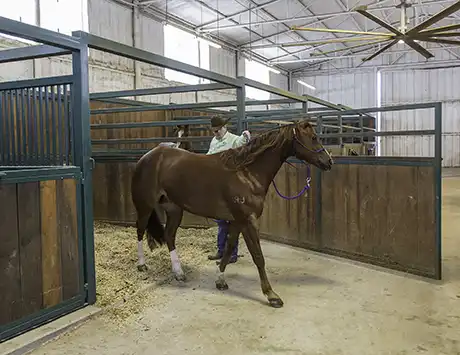

Whenever you’re trying to build your horse’s confidence, always find a starting point. In this situation, the starting point is opening the stall door as wide as you possibly can, giving the horse as much room as possible to go in and out of the stall. If your stall door swings open on hinges, be sure to secure it into place so that it doesn’t accidentally close and scare your horse.
Using the Sending Exercise, ask the horse to go in and out of the stall. Stand with your back toward the stall door and send the horse out of the stall, keeping your feet still. When he passes your belly button, yield his hindquarters and have him turn to face you. Then send him into the stall. Do this over and over until the horse is comfortable walking into and out of the stall.
While you want the horse to calmly walk into and out of the stall, don’t be surprised if he initially trots through it. Don’t try to stop him from trotting, because that will only make him more nervous. Just keep sending him in and out of the stall until he relaxes on his own and walks.
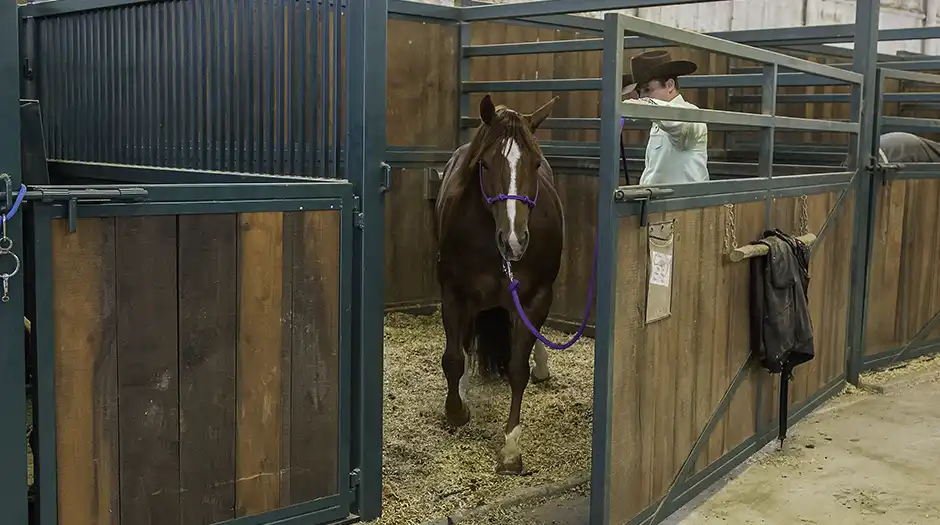
As you build the horse’s confidence, you can gradually close the stall door, asking him to go in and out of a narrower space. It’s important to do this gradually and only close the gap when the horse is confident. If you go from asking the horse to pass between an 8-foot gap to asking him to pass between a 3-foot gap, you’ll wreck his confidence.
As you’re closing the gap, pay close attention that you don’t let the gate accidentally hit him. If it does, you’ll likely have to rebuild his confidence all over again.
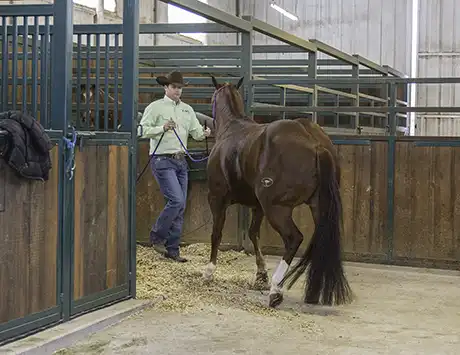
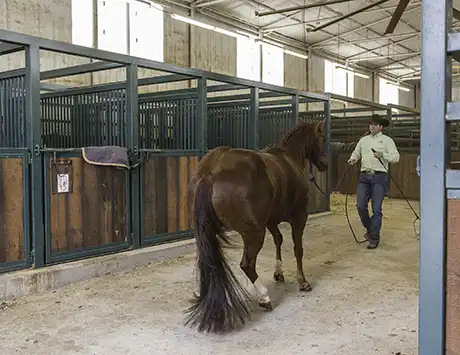
If your horse is less fearful and more in just a hurry to bust out of the stall in anticipation of getting to the pasture with his buddies, instead of leading him out of the stall, back him out of it and down the barn aisle.
Make sure the stall door is opened wide enough for him to safely pass through without bumping into it. Initially, keep the stall door as wide as it’ll go to find a starting point for your horse. As he gets better, you can gradually close the gap to increase the challenge.
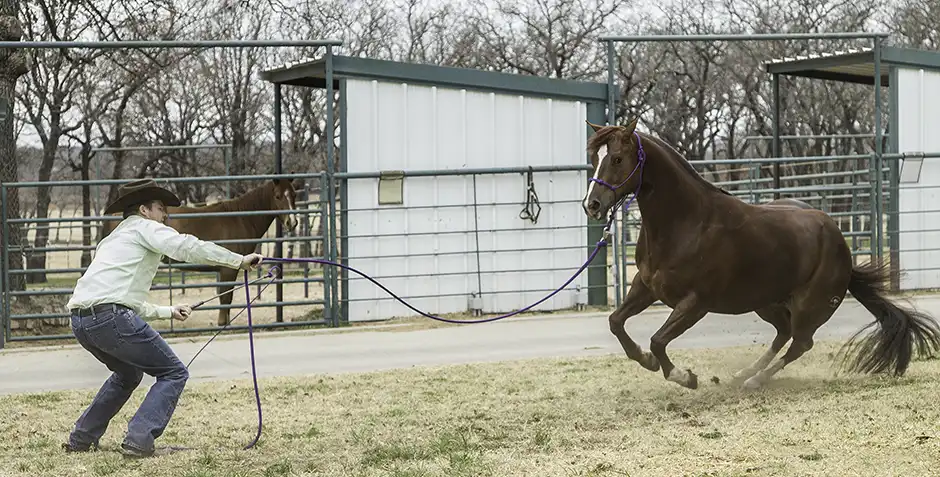
Once you get him outside of the barn, put his feet to work and make him hustle. Horses are masters at predicting our next moves and realizing our routines. If every morning you come into the barn at 8 a.m. to feed your horse and then take him out to the pasture, he knows what you’re up to. As soon as he hears you enter the barn, he’s ready to be turned out.
This exercise of backing him out of the stall and barn and then moving his feet will show him that just because you get him out of the stall, it doesn’t mean that he’s going to get turned out straightaway. When he’s with you, he needs to have his attention on you and be respectful about what you’re asking him to do.
It doesn’t matter how you move the horse’s feet, just that you do as many changes of direction as you possibly can. A great exercise to practice is Lunging for Respect Stage Two, where you’ll ask the horse to trot energetically in a circle around you and then yield his hindquarters and roll back into the opposite direction he was going.
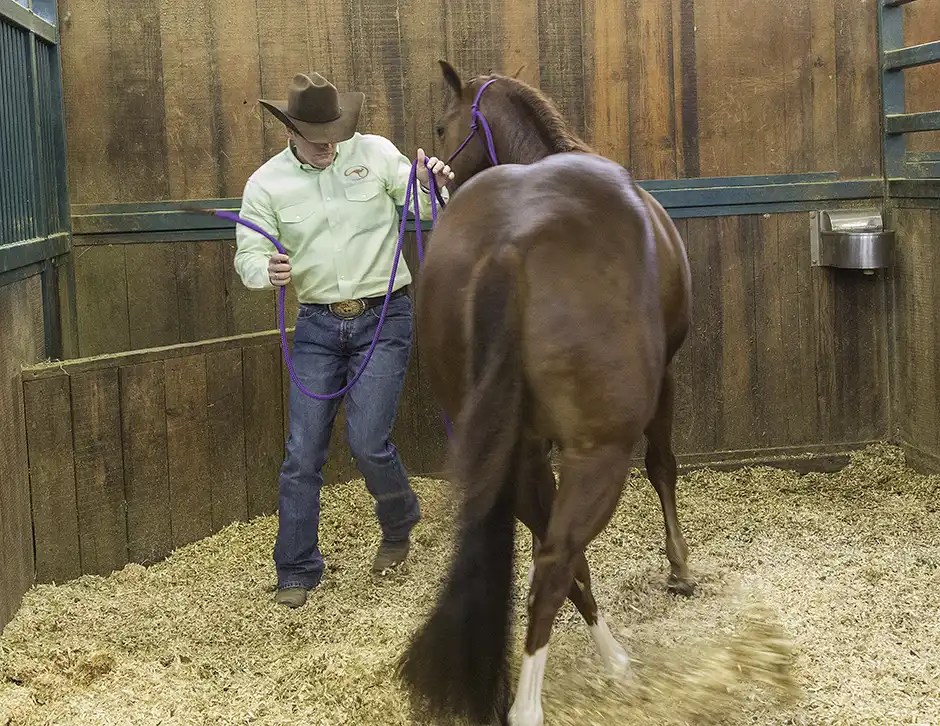
If your horse has a tendency to push you out of the way and rush back into the stall to get to his feed, you can put the same exercise to work. As soon as he gets into the stall, hustle his feet. Because the space you have to work with is limited, an exercise such as Yield the Hindquarters is ideal.
After you’ve hustled the horse’s feet, send him out of the stall and back in again. If he bolts into the stall, immediately put his feet to work. With repetition, he’ll learn that running into the stall only means he has to hustle his feet and work up a sweat—it’s not getting him to his grain faster.
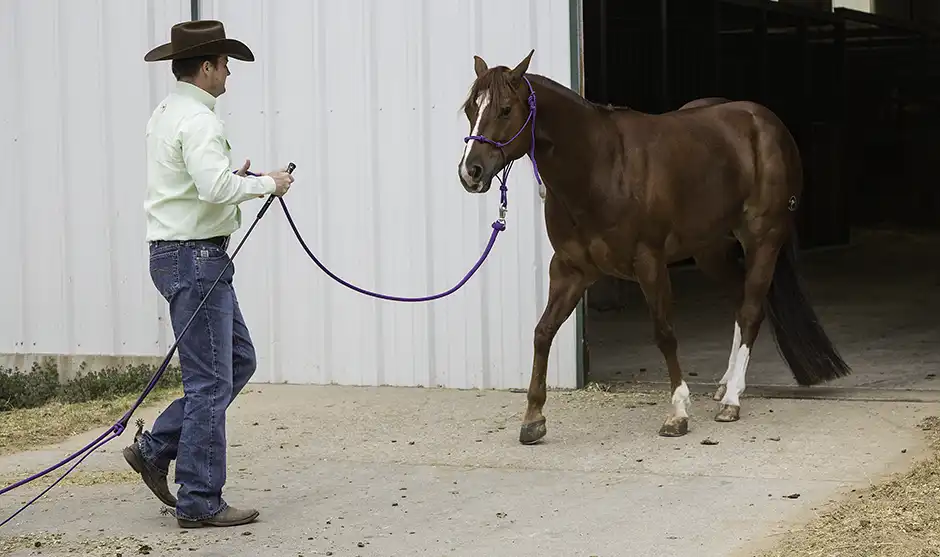
When your horse no longer has any issues about going into and out of the stall, challenge him. Back him into the barn and into his stall. See how narrow a gap you can get the horse to back through.

Master Your horsemanship Skills
Like these tips? Join the No Worries Club and hone your skills with thousands of hours of Clinton’s easy, step-by-step method horse training videos.



